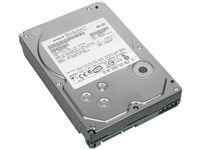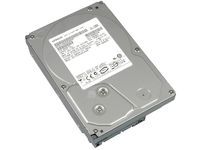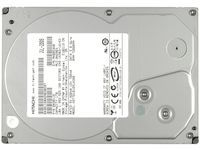Tom’s Winter 2008 Hard Drive Guide
Hitachi: Deskstar 7K1000 and Deskstar 7K1000.B

There are currently three Hitachi mainstream hard drive families on the market: the Deskstar 7K1000, the 7K1000.B and the E7K1000. The first one is the first generation terabyte drive, the .B drive is the second generation, and the E7K1000 is the new low-power drive that is based on the second generation. We have not yet received the E7K1000, but looked at the other two.
Deskstar 7K1000: First Generation Terabyte Oldie
Hitachi’s first-generation Deskstar 7K1000 was released in spring 2007, and the firm deserves kudos for having released the first hard drive that provided a total capacity of one terabyte. The drive reached its capacity using five storage platters, and had a 7,200 RPM spindle speed, a Serial ATA/300 interface and 32 MB of cache memory—this was also the first time this cache capacity was deployed.
However, the Deskstar 7K1000 can no longer be considered a modern hard drive—there are faster and more efficient drives around, including the 7K1000.B. If you intend to go for a Hitachi drive, be sure you don’t get the HDS721010KLA330 Deskstar 7K1000, as it gets hotter and delivers less performance than its successor.

Deskstar 7K1000.B: B Like Better
The Deskstar 7K1000.B is Hitachi’s latest terabyte hard drive. While other hard drive makers such as Seagate decided to jump to the next capacity point of 1.5 TB right away, Hitachi preferred to create a new terabyte drive. The 7K1000.B at 1 TB capacity is called HDT721010SLA360, and is based on three platters instead of five. It still utilizes Serial ATA/300 and the same 7,200 RPM spindle speed, but the cache capacity was reduced from 32 MB to 16 MB, which didn’t hurt performance at all. To the contrary, the Deskstar 7K1000.B is one of the fastest and most balanced hard drives available today. It pairs great performance with power efficiency.

While the old Deskstar 7K1000 was available only at 750 GB or 1000 GB, the new 7K1000.B is available at all capacity points. You can choose among 160, 250, 320, 500, 640, 750 and 1,000 GB models. Typically, the 640 GB or 750 GB models offer the best cost per gigabyte ratio. Please consider that the higher capacity versions require more power due to the larger number of platters and that performance varies from one capacity point to the other, depending on how much of the total recording area of each platter is actually being used.
Stay on the Cutting Edge
Join the experts who read Tom's Hardware for the inside track on enthusiast PC tech news — and have for over 25 years. We'll send breaking news and in-depth reviews of CPUs, GPUs, AI, maker hardware and more straight to your inbox.
Current page: Hitachi: Deskstar 7K1000 and Deskstar 7K1000.B
Prev Page Desktop HDDs: Differences Next Page Samsung: Spinpoint FMost Popular

